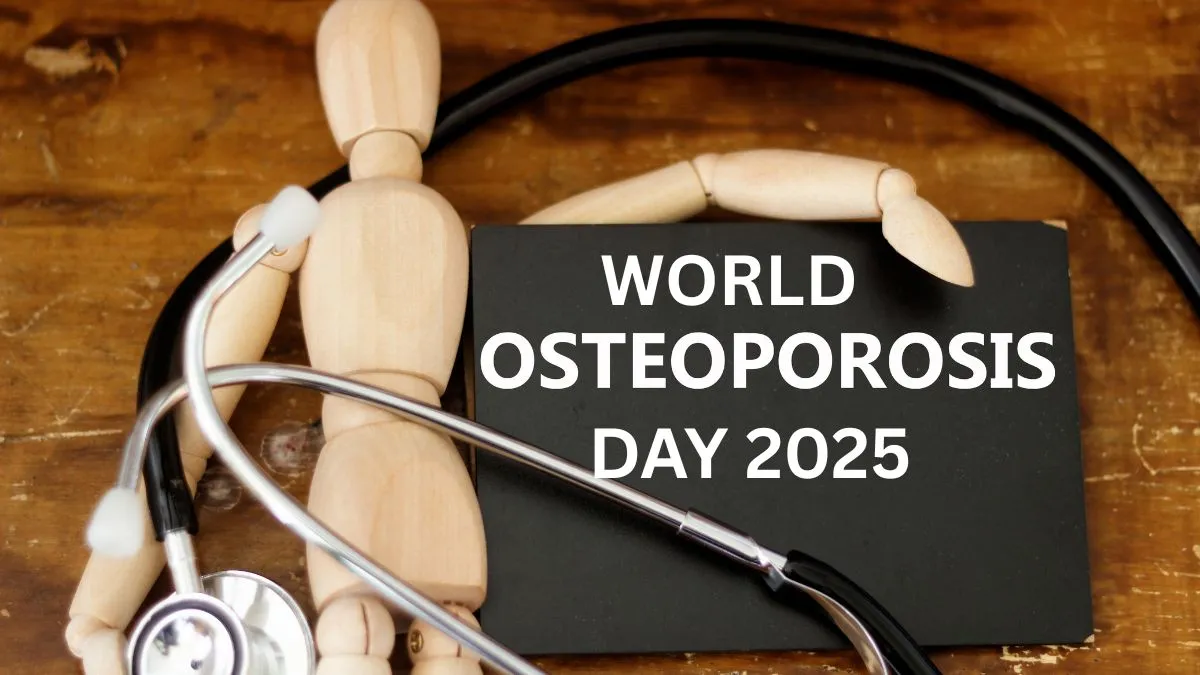- By Bornika Das
- Sun, 19 Oct 2025 04:22 PM (IST)
- Source:JND
World Osteoporosis Day 2025: World Osteoporosis Day 2025, celebrated annually on October 20, reminds everyone of the importance of bone health and of eliminating myths that have been around for generations regarding this insidious disease. Osteoporosis makes bones brittle, leading to sudden fractures, especially in women and the elderly. Though widespread, it usually goes undetected until a severe injury takes place. To counter this, health professionals are calling for early diagnosis, proper diet, and a change of lifestyle as the prevention keys. Besides debunking myths about osteoporosis, including the one that it happens only in old age or that taking calcium tablets can reverse the condition.
Periodic awareness campaigns emphasise that osteoporosis is a controllable disease when met with a positive approach of knowledge and habits. Misconceptions regarding symptoms, risk factors, and the treatment of osteoporosis usually deter people from getting early medical consultation. This year, doctors are urging individuals, particularly post-menopausal women, to get bone density tests and adopt weight-bearing exercises. In conversation with The Daily Jagran, Dr. H.N. Ravikumar, Chief of Lab Operations, Metropolis Healthcare Limited, Karnataka, explains what osteoporosis is and debunks certain myths to lower the risk and have strong and healthier bones.
What Is Osteoporosis?
Osteoporosis is a metabolic bone disorder characterized by reduced bone mass, which weakens bones and significantly increases the risk of fractures. With an aging population like India and a longer life span, osteoporosis is increasingly becoming a global epidemic. Today, it has been found that more than 200 million people worldwide are suffering from osteoporosis.
According to recent statistics from the International Osteoporosis Foundation, 1 in 3 women over the age of 50 years and 1 in 5 men will experience fractures in their lifetime due to osteoporosis. Every fracture is a warning sign of another impending one. What makes osteoporosis particularly dangerous is that it has no clinical manifestations until a fracture occurs.
ALSO READ: Osteoporosis, Symptoms And Best Foods For Bone Health: 7 Must-Have Foods In Your Diet
Common Fracture Sites:
- Vertebra (spine)
- Proximal femur (hip)
- Distal forearm (wrist)
Key Points:
Asymptomatic nature: Osteoporosis is often called a “silent disease” because it does not produce notable symptoms until a fracture occurs.
Impact of fractures: An unexpected fracture can have a major, life-altering impact, especially on older or working individuals, potentially leading to financial burden and dependency.
Classification Of Osteoporosis:
Osteoporosis is categorized based on its underlying cause.
1. Primary Osteoporosis
This type occurs naturally and is not caused by other diseases.
Post-menopausal osteoporosis: Primarily affects women due to estrogen deficiency after menopause.
Senile osteoporosis: Occurs in both men and women because of natural aging.

Osteoporosis Myths Debunked (Image Credits: Canva)
2. Secondary Osteoporosis
This type results from external factors, chronic conditions, or medications.
Genetic diseases: Such as osteogenesis imperfecta and cystic fibrosis.
Lifestyle factors: Vitamin D insufficiency, smoking, alcohol abuse, physical inactivity, low calcium intake, and immobilization.
Chronic diseases: Diabetes, central obesity, hyperthyroidism, hyperparathyroidism, Cushing’s syndrome, many cancers, chronic infections like HIV, and chronic heart, lung, and kidney diseases.
Hormonal imbalances: Low androgen (men) or low estrogen (women) levels.
Drugs: Long-term use of steroids, chemotherapeutic agents, or excessive thyroid hormones.
Breaking The Myths: Why Lab Tests Matter
One of the biggest myths about osteoporosis is that it can be identified based on symptoms or general health alone. Dr. H.N. Ravikumar states, “Osteoporosis often remains undiagnosed until a fracture occurs, by which time significant bone loss has already taken place.” Laboratory and diagnostic tests are therefore essential to ensure accurate diagnosis, early detection, and prevention of misdiagnosis of osteoporosis.
Diagnosis And Screening:
Early diagnosis is crucial to begin prevention and treatment before fractures occur.
Diagnostic Methods:
DEXA Scan (Dual-Energy X-ray Absorptiometry): The gold standard for measuring bone mineral density (BMD). A T-score of -2.5 or lower confirms osteoporosis in postmenopausal women and men over 50.
Routine blood tests: Include tests for diabetes, kidney and liver function (KFT, LFT), vitamin D, and calcium levels to rule out secondary causes.
Osteoporosis profile: May include hormonal tests like estrogen (for women), androgen (for men), PTH, and thyroid hormones, along with newer bone markers.
Specialised Lab Tests:
Newer tests help diagnose and monitor treatment by measuring markers of bone remodeling
Bone-specific alkaline phosphatase
B2 CrossLaps
DPD/Pyrilinks-D
Osteocalcin (BGP)
These markers offer valuable insights into bone turnover, helping clinicians distinguish between different causes of low bone density and tailor treatment, accordingly, reducing the risk of misdiagnosis.
Recommended Health Check-Ups:
Regular screening is vital, especially for high-risk groups:
Women: Annual check-ups starting at age 45 years or earlier, depending on menopause status and risk factors like family history, low body weight, chronic diseases, or long-term steroid use.
Regular bone health assessments using DEXA scans and laboratory profiles can detect bone loss even before fractures occur, allowing timely intervention.
Prevention:
Proactive steps can help maintain strong bones throughout life and prevent misdiagnosis through comprehensive testing and early detection.
Step 1: Lifestyle Changes
Nutrition: Ensure a diet rich in calcium and vitamin D.
Exercise: Engage in regular, weight-bearing exercises like walking and yoga to improve balance and strengthen muscles.
Avoid harmful habits: Refrain from smoking and limit alcohol consumption.
ALSO READ: Bone Health After 40: Doctor Lists Tips For Mothers To Prevent Osteoporosis
Step 2: Regular Health Monitoring
Get yearly health check-ups to rule out both primary and secondary causes of osteoporosis.
Include DEXA scans and an osteoporosis lab profile in these check-ups.
Regular consultation with doctors and monitoring bone status through lab testing is the best way to protect your bones.
Do not wait for a fracture to destabilize you. Early testing, timely prevention, and proper monitoring can prevent osteoporosis and its life-altering consequences.

